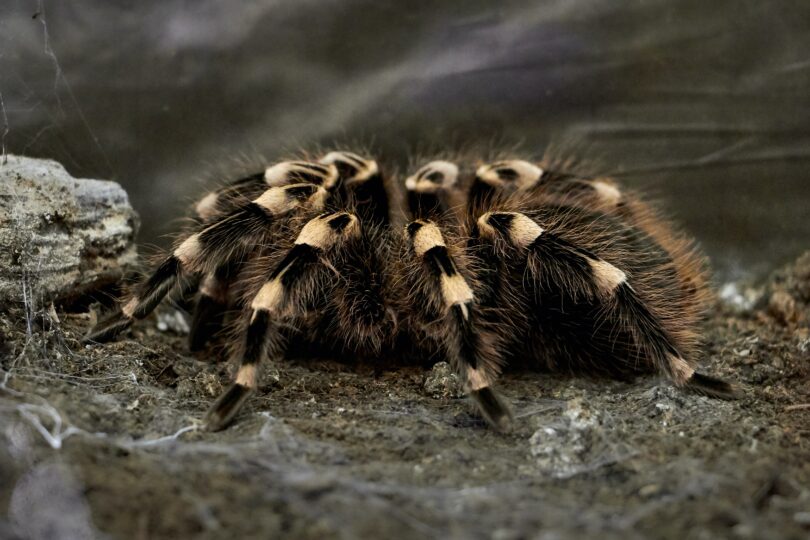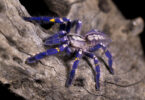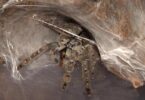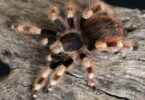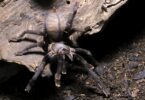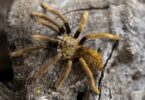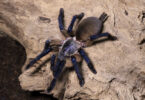Venturing into the world of exotic pets often brings enthusiasts face-to-face with the Acanthoscurria geniculata—also known as the Brazilian White Knee Tarantula. Despite its daunting appearance and misunderstood demeanor, this New World spider offers a fascinating glimpse into the richness of Brazil’s arachnid fauna.
With years spent observing these captivating creatures, I’ve uncovered that behind their impressive leg span and sharp colors lies a creature less fearsome than folklore suggests.
These tarantulas captivate not only with their striking black and white banded legs but also by illustrating resilience in both nature and captivity—a trait that endears them to beginners and expert hobbyists alike.
Discover how such an incredible species thrives, what it takes to care for them properly, and why their presence can transform apprehension into admiration. Stay curious—the wonders of Acanthoscurria geniculata await you.
Key Takeaways
- The Brazilian White Knee Tarantula is a large spider with black and white banded legs, living in the forests of Northern Brazil.
- They need a tank with wet and dry areas, warm temperatures between 76-80 degrees Fahrenheit, and shelters to hide in.
- These tarantulas eat insects like crickets, roaches or mealworms.
- They can be feisty and have irritating hairs, so it’s best not to handle them too much for safety reasons.
- A proper environment and diet help this species live up to 20 years.
Natural History of the Brazilian White Knee Tarantula
Dive into the rich tapestry of the Acanthoscurria geniculata’s background, where this striking species thrives in its lush, Amazonian realm. Uncover the unique attributes and daily rituals that define the existence of these captivating giants within their natural Brazilian landscape.
Distribution and Habitat
The Brazilian White Knee Tarantula calls the lush, green forests of Northern Brazil its home. These spiders love the warm and wet places where they can hide under logs or in burrows.
Rainfall is common in their natural habitat, making it a perfect spot for them to live. They share this place with all sorts of creatures like lizards and other insects. You’ll find the Acanthoscurria geniculata living happily among the trees and plants that grow thick in the Amazon Basin.
They are not hard to find if you know where to look in these big forests. The giant white knee tarantula has made quite a space for itself there. Its habitat is full of life and supports lots of different animals and plants.
This spider does well here because it can find food easily and has lots of spots to stay safe from danger.
Physical Description and Behavior
Acanthoscurria geniculata is a large spider with a leg span that reaches up to 8 inches. This tarantula has striking black and white banded legs that stand out against its dark body.
On their abdomen, they carry urticating hairs ready to be kicked in your direction as a defense tactic. When scared or threatened, these spiders would rather hide than fight.
This species is known for being feisty at times but tends to calm down as it grows older. Handling them can be tricky due to their irritating hairs and quick movements. It’s best to enjoy watching them from a safe distance instead of trying to touch them.
They show interesting behaviors like rearranging their habitat and hunting prey with speed and precision.
Keeping Acanthoscurria geniculata as Pets
Enter the world of exotic pet keeping with Acanthoscurria geniculata, where you can cultivate a mini habitat that closely aligns with their wild environments. Learn essential care practices to ensure your tarantula thrives under your watchful eye.
Housing and Environment Setup
To keep a Brazilian White Knee Tarantula happy, you need the right home for it. Start with a wide tank because they like to walk around more than climb. The bottom should have at least 4 inches of substrate like soil or coconut fiber.
This lets them dig and make comfy spots to hide. Make sure one side is moist (humidity around 60-70%) so they can choose where they feel best.
Put in a shelter like half a log or a cork bark on its side for them to hide under. Keep the tank’s temperature between 76-80 degrees Fahrenheit during the day. It’s okay if it drops a bit at night but don’t let it get too cold.
A water dish is good but ensure it’s shallow to prevent any accidents.
Diet and Nutrition
Feeding tarantula the right food is important. Baby spiderlings eat little crickets or roaches twice a week. They stop eating when they are getting ready to molt, which means shed their old skin for new.
Adult tarantulas like big meals less often. Give them couple crickets or big dubia roaches every two weeks.
This type of tarantula loves to eat and will quickly jump on their food. Make sure you feed them enough but not too much because overfeeding can harm them. Watch how they hunt and pounce; it’s exciting and shows their strong appetite!
Health and Maintenance Tips
Keep your Brazilian White Knee tarantula healthy by setting up their home right. Use a wide tank with a dry place for them to walk and a wet spot for moisture. Keep the temperature cozy between 76-80 degrees Fahrenheit.
Give spiderlings tiny Turkish roaches because they don’t burrow in the substrate. When they stop eating because they’re about to molt, that’s normal – don’t worry! For big tarantulas, once every week is enough.
Be careful with these pets as they have special hairs that can irritate skin and eyes. It’s best not to handle them too much. Their enclosure needs cleaning sometimes, but not too often, to avoid stress.
Always watch your tarantula’s behavior; changes could mean something is wrong. A happy tarantula means you’re doing things right!
Conclusion
The Brazilian White Knee Tarantula makes for an eye-catching pet with its bold colors and active nature. Though it may not be the best for handling, its striking looks offer plenty to admire from afar.
This spider’s care requirements are straightforward, making it a good choice even for those new to tarantulas. Remember, providing the right home and diet will keep your eight-legged friend happy and healthy.
If you’re ready for a pet that stands out, the Acanthoscurria geniculata could be just what you’re looking for!
FAQs
1. What is the temperament of an Acanthoscurria geniculata?
The Acanthoscurria geniculata, also known as the Brazilian White Knee Tarantula, can be feisty and may sometimes bite if it feels threatened. It’s essential to remember that tarantulas react to vibrations, including those caused by our hands. Therefore, even the most gentle species might bite us, thinking we are prey.
2. How do you breed Acanthoscurria geniculata?
To breed the Brazilian Whiteknee Tarantula, put a male and female together after they are fully grown. Watch them carefully because sometimes they fight. If all goes well, the female will make an egg sac with even 1000 baby spiders inside.
3. Is the Acanthoscurria geniculata a New World tarantula?
Yes, the Brazilian White Knee Tarantula is a type of New World tarantula that comes from places in South America like Brazil.
4. How venomous is Acanthoscurria geniculata?
Acanthoscurria geniculata possesses very weak venom, but an adult individual has large venomous fangs, and encountering them is certainly not pleasant.

